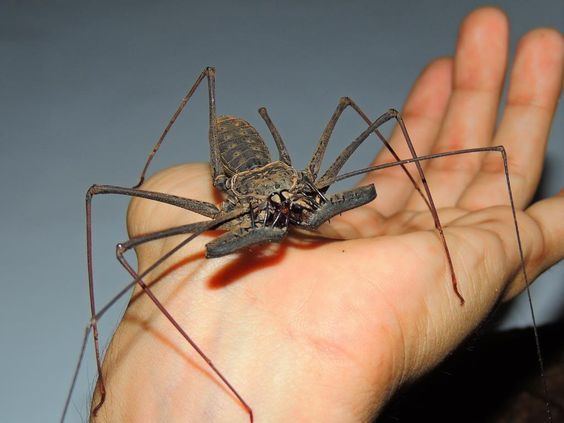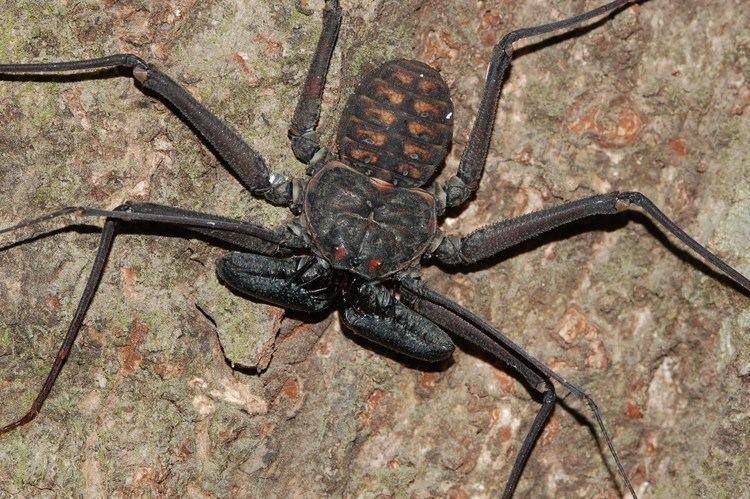Rank Order Higher classification Tetrapulmonata | Scientific name Amblypygi | |
 | ||
Similar Thelyphonida, Arachnid, Sun spiders, Pseudoscorpion, Harvestmen | ||
Amblypygi tailess whip scorpion
Amblypygi is an ancient order of arachnid chelicerate arthropods also known as whip spiders and tailless whip scorpions (not to be confused with whip scorpions and vinegaroons that belong to the related order Thelyphonida). The name "amblypygid" means "blunt rump", a reference to a lack of the flagellum ("tail") that is otherwise seen in whip scorpions. They are harmless to humans. Amblypygids possess no silk glands or venomous fangs. They rarely bite if threatened, but can grab fingers with their pedipalps, resulting in thorn-like puncture injuries.
Contents
- Amblypygi tailess whip scorpion
- Red forest scorpion vs amblypygid monster bug wars
- Physical description
- Behaviour
- Genera
- References

As of 2016, 5 families, 17 genera and around 155 species had been discovered and described. They are found in tropical and subtropical regions worldwide. Some species are subterranean; all are nocturnal. Fossilized amblypygids have been found dating back to the Carboniferous period, such as Graeophonus.

Red forest scorpion vs amblypygid monster bug wars
Physical description

Amblypygids range from 5 to 70 centimetres (2.0 to 27.6 in) in legspan. Their bodies are broad and highly flattened, with a solid carapace and a segmented abdomen. Most species have eight eyes; a pair of median eyes at the front of the carapace above the chelicerae and 2 smaller clusters of three eyes each further back on each side.

Amblypygids have raptorial pedipalps modified for grabbing and retaining prey, much like those of a mantis. The first pair of legs act as sensory organs and are not used for walking. The sensory legs are very thin and elongate, have numerous sensory receptors, and can extend several times the length of body.
Behaviour
Amblypygids have eight legs, but use only six for walking, often in a crab-like, sideways fashion. The front pair are modified for use as antennae-like feelers, with many fine segments giving the appearance of a "whip". When a suitable prey is located with the antenniform legs, the amblypygid seizes its victim with the long spines on the grasping pedipalps, before masticating the captured prey with its central pincer-like chelicerae.
Courtship involves the male depositing stalked spermatophores, which have one or more sperm masses at the tip, onto the ground, and using his pedipalps to guide the female over them. She gathers the sperm and lays fertilized eggs into a sac carried under the abdomen. When the young hatch, they climb up onto the mother's back; any which fall off before their first moult will not survive.
Some species of amblypygids, particularly Phrynus marginemaculatus and Damon diadema, may be among the few examples of arachnids that exhibit social behavior. Research conducted at Cornell University suggests that mother amblypygids communicate with their young with her antenniform front leg, and the offspring reciprocate both with their mother and siblings. The ultimate function of this social behavior remains unknown. Amblypygids hold territories that they defend from other individuals.
The amblypygid diet mostly consists of arthropod prey, but this opportunistic predator has also been observed feeding on vertebrates. Before, during and after molting they generally do not feed. Like any other arachnid, an amblypygid will molt several times during its life.
Genera
The following genera are recognised:
family unspecified
